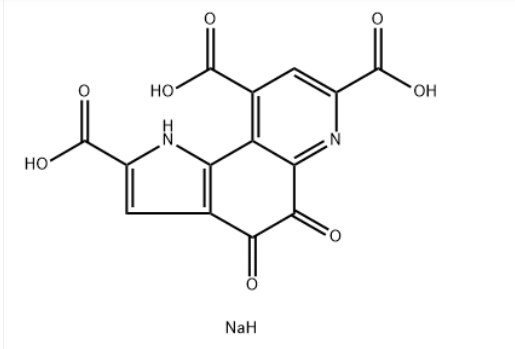
IdentificationPhysical DataSpectraRoute of Synthesis (ROS)Safety and HazardsOther Data
Identification
Product NamePyrroloquinoline quinone Dosodium SaltIUPAC Namedisodium;2-carboxy-4,5-dioxo-1H-pyrroloquinoline-7,9-dicarboxylate Molecular StructureCAS Registry Number 122628-50-6EINECS Number209-118-9MDL NumberMFCD00151711Beilstein Registry NumberSynonyms122628-50-6Methoxatin disodium saltMethoxatin DisodiumDisodium 4,5-dihydro-4,5-dioxo-1H-pyrrolo(2,3-f)quinoline-2,7,9-tricarboxylatePYRROLOQUINOLINE QUINONE DISODIUM SALTdisodium;2-carboxy-4,5-dioxo-1H-pyrroloquinoline-7,9-dicarboxylateDisodium pyrroloquinolinedione tricarboxylate1H-Pyrrolo(2,3-f)quinoline-2,7,9-tricarboxylic acid, 4,5-dihydro-4,5-dioxo-, disodium salt8WX58ADB2Epyrroloquinoline quinone disodiumPyrroloquinolinequinone disodium saltPQQUNII-8WX58ADB2EMethoxatin (disodium salt)PyrroloquinolineQuinoneDisodiumPyrroloquinolinequinone disodiumSCHEMBL16277415DTXSID10924223BCP16823MFCD00151711AKOS037647712CCG-268344FT-0690199C71852A927467J-004837Disodium 2-carboxy-4,5-dioxo-4,5-dihydro-1H-pyrroloquinoline-7,9-dicarboxylateSodium 2-carboxy-4,5-dioxo-4,5-dihydro-1H-pyrroloquinoline-7,9-dicarboxylatesodium 9-carboxy-4,5-dioxo-4,5-dihydro-1H-pyrroloquinoline-2,7-dicarboxylateMethoxatin disodium salt; Methoxatin Disodium; UNII-8WX58ADB2E; PYRROLOQUINOLINE QUINONE DISODIUM SALTMolecular FormulaC14H4N2Na2O8Molecular Weight374.17InChI InChI=1S/C14H6N2O8.2Na/c17-10-4-2-6(14(23)24)15-8(4)7-3(12(19)20)1-5(13(21)22)16-9(7)11(10)18;;/h1-2,15H,(H,19,20)(H,21,22)(H,23,24);;/q;2*+1/p-2 InChI KeyUFVBOGYDCJNLPM-UHFFFAOYSA-L Canonical SMILESC1=C(C2=C(C(=O)C(=O)C3=C2NC(=C3)C(=O)O)N=C1C(=O))C(=O)..
Physical Data
AppearanceReddish orange to reddish brown powder
Spectra
No data available
Route of Synthesis (ROS)
No data available
Safety and Hazards
No data available
Other Data
TransportationStore at room temperature, sealed and away from lightStore at room temperature, sealed and away from lightHS CodeStorageStore at room temperature, sealed and away from lightShelf Life2 yearsMarket Price
Use PatternPyrroloquinoline quinone Dosodium Salt CAS #:122628-50-6 the scientific name of PQQ is pyrroloquinoline quinone, which is a new prosthetic group that can treat heart disease, neurological diseases, protect the liver, and maintain mitochondrial function. Pyrroloquinoline quinone is widely found in prokaryotes, plants and mammals. It is not only the prosthetic group of many enzymes, it is responsible for the function of transferring electrons, protons and chemical groups in enzymatic reactions, and can also stimulate The growth of microorganisms, the germination of plant pollen, and the promotion of plant growth.
https://www.chemwhat.com/pyrroloquinoline-quinone-dosodium-salt-cas-122628-50-6/
Comments
Post a Comment